Indigenous Australian Cultures
VerifiedAdded on 2023/06/08
|8
|2320
|477
AI Summary
This paper looks into the events in the history of Australia that portrays the discrimination and injustice against the indigenous Australians. The paper intends to compare and analyze two events from the history of the nation; one from pre Commonwealth Referendum in 1967 and the other one from post Referendum period.
Contribute Materials
Your contribution can guide someone’s learning journey. Share your
documents today.
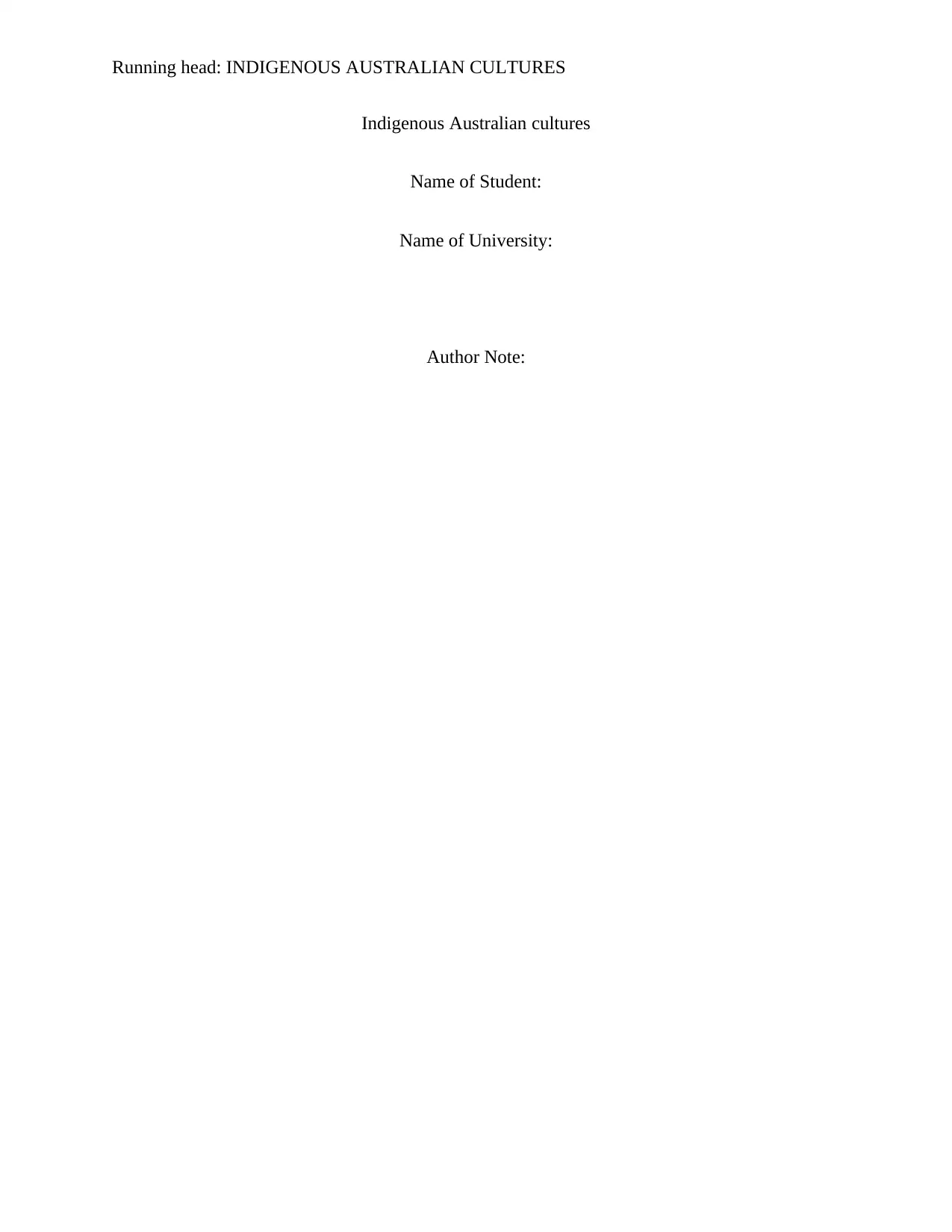
Running head: INDIGENOUS AUSTRALIAN CULTURES
Indigenous Australian cultures
Name of Student:
Name of University:
Author Note:
Indigenous Australian cultures
Name of Student:
Name of University:
Author Note:
Secure Best Marks with AI Grader
Need help grading? Try our AI Grader for instant feedback on your assignments.
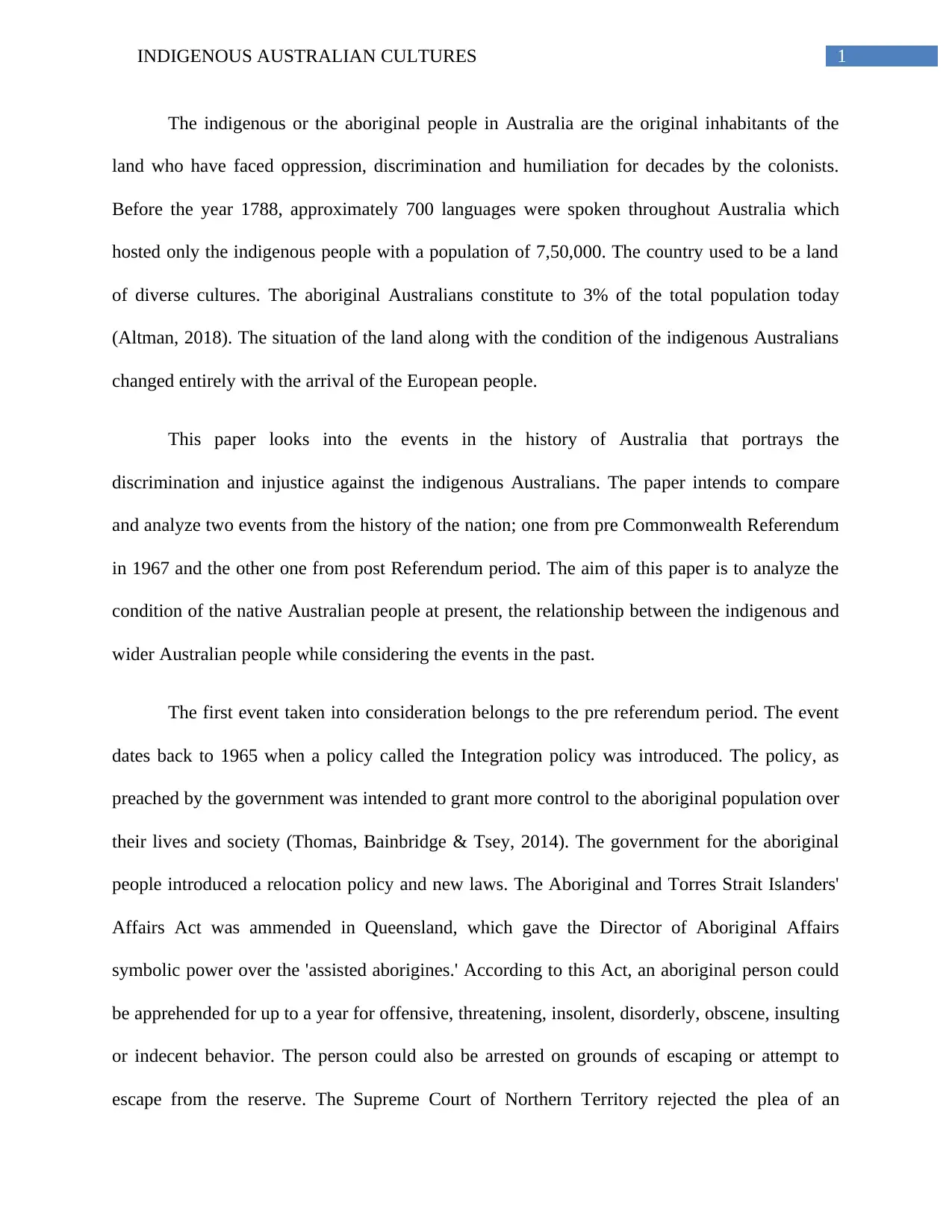
1INDIGENOUS AUSTRALIAN CULTURES
The indigenous or the aboriginal people in Australia are the original inhabitants of the
land who have faced oppression, discrimination and humiliation for decades by the colonists.
Before the year 1788, approximately 700 languages were spoken throughout Australia which
hosted only the indigenous people with a population of 7,50,000. The country used to be a land
of diverse cultures. The aboriginal Australians constitute to 3% of the total population today
(Altman, 2018). The situation of the land along with the condition of the indigenous Australians
changed entirely with the arrival of the European people.
This paper looks into the events in the history of Australia that portrays the
discrimination and injustice against the indigenous Australians. The paper intends to compare
and analyze two events from the history of the nation; one from pre Commonwealth Referendum
in 1967 and the other one from post Referendum period. The aim of this paper is to analyze the
condition of the native Australian people at present, the relationship between the indigenous and
wider Australian people while considering the events in the past.
The first event taken into consideration belongs to the pre referendum period. The event
dates back to 1965 when a policy called the Integration policy was introduced. The policy, as
preached by the government was intended to grant more control to the aboriginal population over
their lives and society (Thomas, Bainbridge & Tsey, 2014). The government for the aboriginal
people introduced a relocation policy and new laws. The Aboriginal and Torres Strait Islanders'
Affairs Act was ammended in Queensland, which gave the Director of Aboriginal Affairs
symbolic power over the 'assisted aborigines.' According to this Act, an aboriginal person could
be apprehended for up to a year for offensive, threatening, insolent, disorderly, obscene, insulting
or indecent behavior. The person could also be arrested on grounds of escaping or attempt to
escape from the reserve. The Supreme Court of Northern Territory rejected the plea of an
The indigenous or the aboriginal people in Australia are the original inhabitants of the
land who have faced oppression, discrimination and humiliation for decades by the colonists.
Before the year 1788, approximately 700 languages were spoken throughout Australia which
hosted only the indigenous people with a population of 7,50,000. The country used to be a land
of diverse cultures. The aboriginal Australians constitute to 3% of the total population today
(Altman, 2018). The situation of the land along with the condition of the indigenous Australians
changed entirely with the arrival of the European people.
This paper looks into the events in the history of Australia that portrays the
discrimination and injustice against the indigenous Australians. The paper intends to compare
and analyze two events from the history of the nation; one from pre Commonwealth Referendum
in 1967 and the other one from post Referendum period. The aim of this paper is to analyze the
condition of the native Australian people at present, the relationship between the indigenous and
wider Australian people while considering the events in the past.
The first event taken into consideration belongs to the pre referendum period. The event
dates back to 1965 when a policy called the Integration policy was introduced. The policy, as
preached by the government was intended to grant more control to the aboriginal population over
their lives and society (Thomas, Bainbridge & Tsey, 2014). The government for the aboriginal
people introduced a relocation policy and new laws. The Aboriginal and Torres Strait Islanders'
Affairs Act was ammended in Queensland, which gave the Director of Aboriginal Affairs
symbolic power over the 'assisted aborigines.' According to this Act, an aboriginal person could
be apprehended for up to a year for offensive, threatening, insolent, disorderly, obscene, insulting
or indecent behavior. The person could also be arrested on grounds of escaping or attempt to
escape from the reserve. The Supreme Court of Northern Territory rejected the plea of an
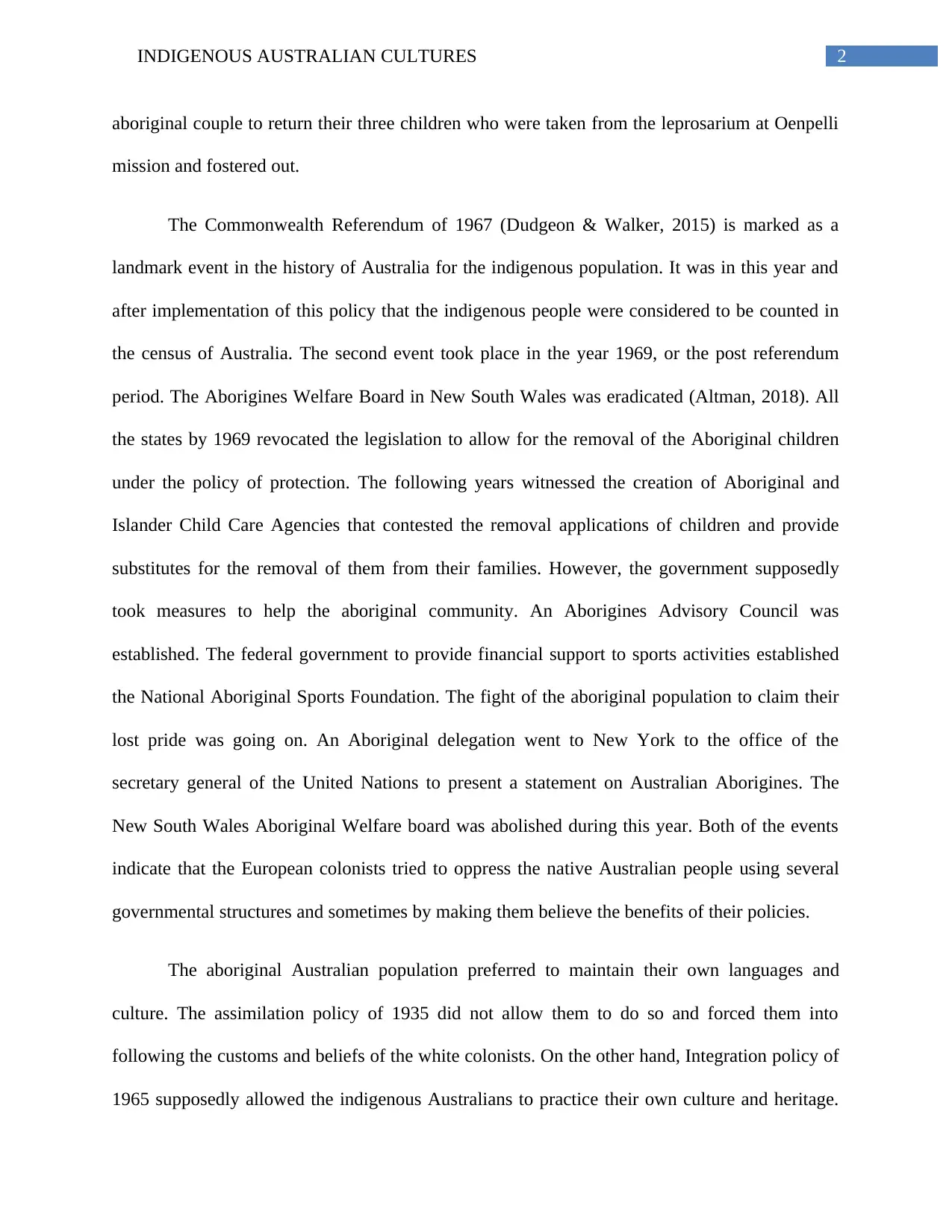
2INDIGENOUS AUSTRALIAN CULTURES
aboriginal couple to return their three children who were taken from the leprosarium at Oenpelli
mission and fostered out.
The Commonwealth Referendum of 1967 (Dudgeon & Walker, 2015) is marked as a
landmark event in the history of Australia for the indigenous population. It was in this year and
after implementation of this policy that the indigenous people were considered to be counted in
the census of Australia. The second event took place in the year 1969, or the post referendum
period. The Aborigines Welfare Board in New South Wales was eradicated (Altman, 2018). All
the states by 1969 revocated the legislation to allow for the removal of the Aboriginal children
under the policy of protection. The following years witnessed the creation of Aboriginal and
Islander Child Care Agencies that contested the removal applications of children and provide
substitutes for the removal of them from their families. However, the government supposedly
took measures to help the aboriginal community. An Aborigines Advisory Council was
established. The federal government to provide financial support to sports activities established
the National Aboriginal Sports Foundation. The fight of the aboriginal population to claim their
lost pride was going on. An Aboriginal delegation went to New York to the office of the
secretary general of the United Nations to present a statement on Australian Aborigines. The
New South Wales Aboriginal Welfare board was abolished during this year. Both of the events
indicate that the European colonists tried to oppress the native Australian people using several
governmental structures and sometimes by making them believe the benefits of their policies.
The aboriginal Australian population preferred to maintain their own languages and
culture. The assimilation policy of 1935 did not allow them to do so and forced them into
following the customs and beliefs of the white colonists. On the other hand, Integration policy of
1965 supposedly allowed the indigenous Australians to practice their own culture and heritage.
aboriginal couple to return their three children who were taken from the leprosarium at Oenpelli
mission and fostered out.
The Commonwealth Referendum of 1967 (Dudgeon & Walker, 2015) is marked as a
landmark event in the history of Australia for the indigenous population. It was in this year and
after implementation of this policy that the indigenous people were considered to be counted in
the census of Australia. The second event took place in the year 1969, or the post referendum
period. The Aborigines Welfare Board in New South Wales was eradicated (Altman, 2018). All
the states by 1969 revocated the legislation to allow for the removal of the Aboriginal children
under the policy of protection. The following years witnessed the creation of Aboriginal and
Islander Child Care Agencies that contested the removal applications of children and provide
substitutes for the removal of them from their families. However, the government supposedly
took measures to help the aboriginal community. An Aborigines Advisory Council was
established. The federal government to provide financial support to sports activities established
the National Aboriginal Sports Foundation. The fight of the aboriginal population to claim their
lost pride was going on. An Aboriginal delegation went to New York to the office of the
secretary general of the United Nations to present a statement on Australian Aborigines. The
New South Wales Aboriginal Welfare board was abolished during this year. Both of the events
indicate that the European colonists tried to oppress the native Australian people using several
governmental structures and sometimes by making them believe the benefits of their policies.
The aboriginal Australian population preferred to maintain their own languages and
culture. The assimilation policy of 1935 did not allow them to do so and forced them into
following the customs and beliefs of the white colonists. On the other hand, Integration policy of
1965 supposedly allowed the indigenous Australians to practice their own culture and heritage.
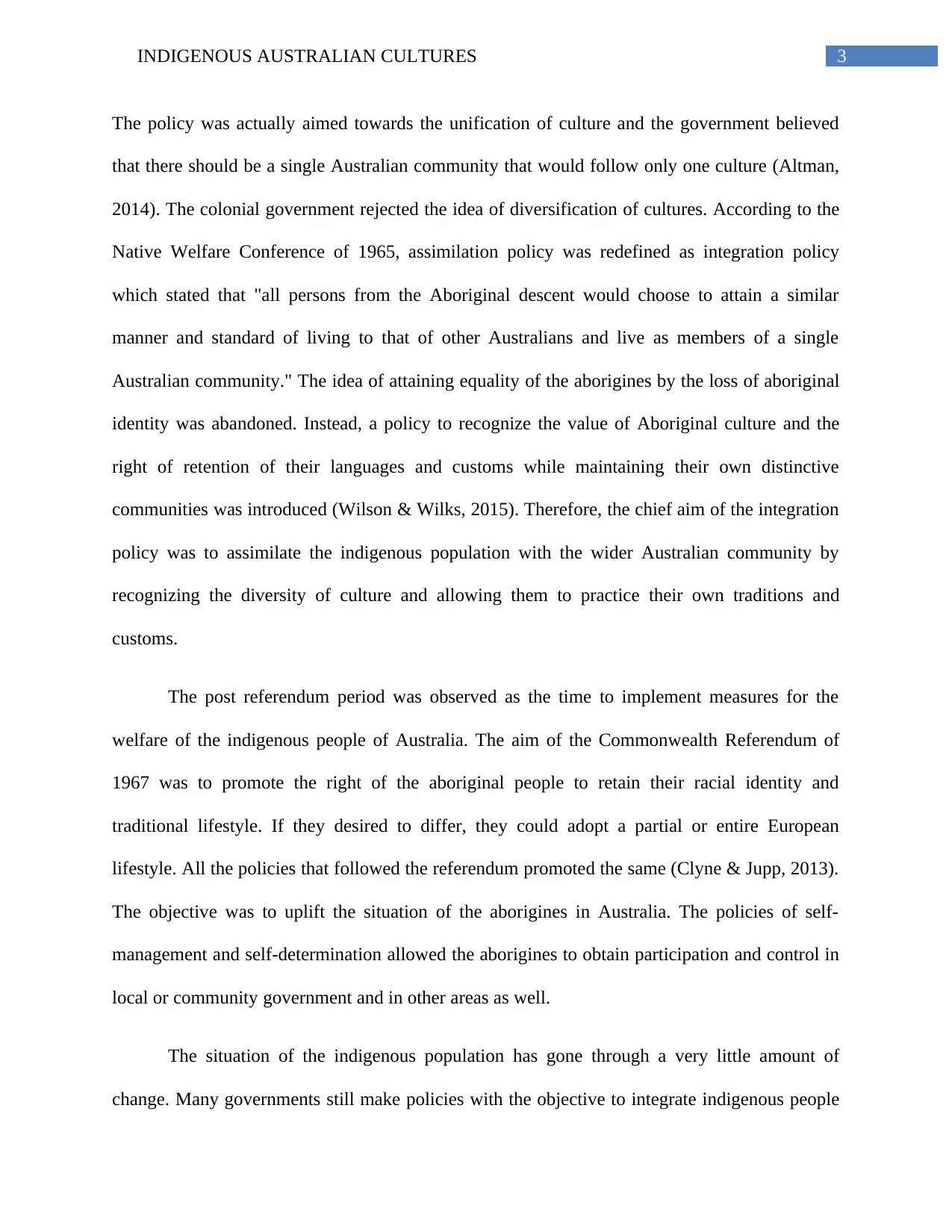
3INDIGENOUS AUSTRALIAN CULTURES
The policy was actually aimed towards the unification of culture and the government believed
that there should be a single Australian community that would follow only one culture (Altman,
2014). The colonial government rejected the idea of diversification of cultures. According to the
Native Welfare Conference of 1965, assimilation policy was redefined as integration policy
which stated that "all persons from the Aboriginal descent would choose to attain a similar
manner and standard of living to that of other Australians and live as members of a single
Australian community." The idea of attaining equality of the aborigines by the loss of aboriginal
identity was abandoned. Instead, a policy to recognize the value of Aboriginal culture and the
right of retention of their languages and customs while maintaining their own distinctive
communities was introduced (Wilson & Wilks, 2015). Therefore, the chief aim of the integration
policy was to assimilate the indigenous population with the wider Australian community by
recognizing the diversity of culture and allowing them to practice their own traditions and
customs.
The post referendum period was observed as the time to implement measures for the
welfare of the indigenous people of Australia. The aim of the Commonwealth Referendum of
1967 was to promote the right of the aboriginal people to retain their racial identity and
traditional lifestyle. If they desired to differ, they could adopt a partial or entire European
lifestyle. All the policies that followed the referendum promoted the same (Clyne & Jupp, 2013).
The objective was to uplift the situation of the aborigines in Australia. The policies of self-
management and self-determination allowed the aborigines to obtain participation and control in
local or community government and in other areas as well.
The situation of the indigenous population has gone through a very little amount of
change. Many governments still make policies with the objective to integrate indigenous people
The policy was actually aimed towards the unification of culture and the government believed
that there should be a single Australian community that would follow only one culture (Altman,
2014). The colonial government rejected the idea of diversification of cultures. According to the
Native Welfare Conference of 1965, assimilation policy was redefined as integration policy
which stated that "all persons from the Aboriginal descent would choose to attain a similar
manner and standard of living to that of other Australians and live as members of a single
Australian community." The idea of attaining equality of the aborigines by the loss of aboriginal
identity was abandoned. Instead, a policy to recognize the value of Aboriginal culture and the
right of retention of their languages and customs while maintaining their own distinctive
communities was introduced (Wilson & Wilks, 2015). Therefore, the chief aim of the integration
policy was to assimilate the indigenous population with the wider Australian community by
recognizing the diversity of culture and allowing them to practice their own traditions and
customs.
The post referendum period was observed as the time to implement measures for the
welfare of the indigenous people of Australia. The aim of the Commonwealth Referendum of
1967 was to promote the right of the aboriginal people to retain their racial identity and
traditional lifestyle. If they desired to differ, they could adopt a partial or entire European
lifestyle. All the policies that followed the referendum promoted the same (Clyne & Jupp, 2013).
The objective was to uplift the situation of the aborigines in Australia. The policies of self-
management and self-determination allowed the aborigines to obtain participation and control in
local or community government and in other areas as well.
The situation of the indigenous population has gone through a very little amount of
change. Many governments still make policies with the objective to integrate indigenous people
Secure Best Marks with AI Grader
Need help grading? Try our AI Grader for instant feedback on your assignments.
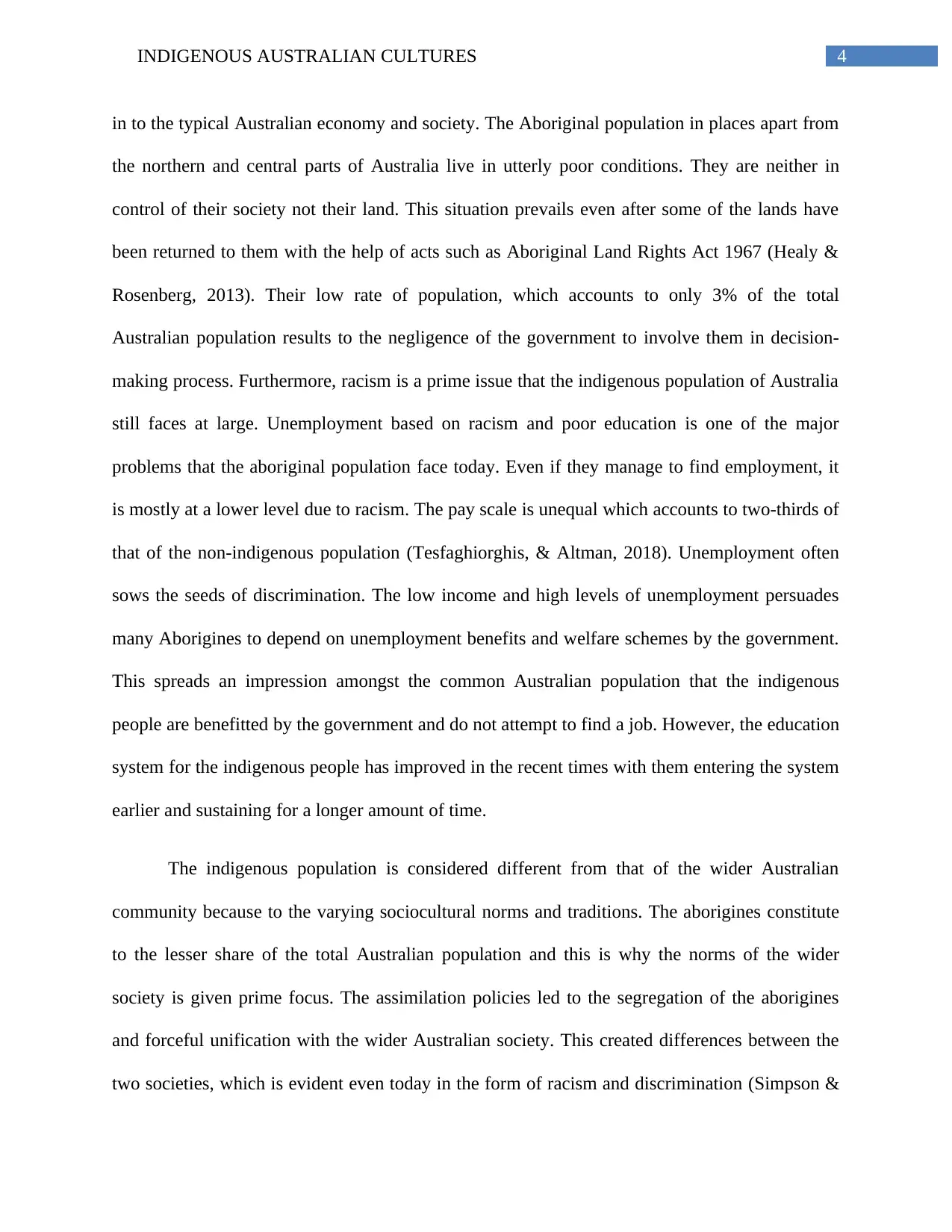
4INDIGENOUS AUSTRALIAN CULTURES
in to the typical Australian economy and society. The Aboriginal population in places apart from
the northern and central parts of Australia live in utterly poor conditions. They are neither in
control of their society not their land. This situation prevails even after some of the lands have
been returned to them with the help of acts such as Aboriginal Land Rights Act 1967 (Healy &
Rosenberg, 2013). Their low rate of population, which accounts to only 3% of the total
Australian population results to the negligence of the government to involve them in decision-
making process. Furthermore, racism is a prime issue that the indigenous population of Australia
still faces at large. Unemployment based on racism and poor education is one of the major
problems that the aboriginal population face today. Even if they manage to find employment, it
is mostly at a lower level due to racism. The pay scale is unequal which accounts to two-thirds of
that of the non-indigenous population (Tesfaghiorghis, & Altman, 2018). Unemployment often
sows the seeds of discrimination. The low income and high levels of unemployment persuades
many Aborigines to depend on unemployment benefits and welfare schemes by the government.
This spreads an impression amongst the common Australian population that the indigenous
people are benefitted by the government and do not attempt to find a job. However, the education
system for the indigenous people has improved in the recent times with them entering the system
earlier and sustaining for a longer amount of time.
The indigenous population is considered different from that of the wider Australian
community because to the varying sociocultural norms and traditions. The aborigines constitute
to the lesser share of the total Australian population and this is why the norms of the wider
society is given prime focus. The assimilation policies led to the segregation of the aborigines
and forceful unification with the wider Australian society. This created differences between the
two societies, which is evident even today in the form of racism and discrimination (Simpson &
in to the typical Australian economy and society. The Aboriginal population in places apart from
the northern and central parts of Australia live in utterly poor conditions. They are neither in
control of their society not their land. This situation prevails even after some of the lands have
been returned to them with the help of acts such as Aboriginal Land Rights Act 1967 (Healy &
Rosenberg, 2013). Their low rate of population, which accounts to only 3% of the total
Australian population results to the negligence of the government to involve them in decision-
making process. Furthermore, racism is a prime issue that the indigenous population of Australia
still faces at large. Unemployment based on racism and poor education is one of the major
problems that the aboriginal population face today. Even if they manage to find employment, it
is mostly at a lower level due to racism. The pay scale is unequal which accounts to two-thirds of
that of the non-indigenous population (Tesfaghiorghis, & Altman, 2018). Unemployment often
sows the seeds of discrimination. The low income and high levels of unemployment persuades
many Aborigines to depend on unemployment benefits and welfare schemes by the government.
This spreads an impression amongst the common Australian population that the indigenous
people are benefitted by the government and do not attempt to find a job. However, the education
system for the indigenous people has improved in the recent times with them entering the system
earlier and sustaining for a longer amount of time.
The indigenous population is considered different from that of the wider Australian
community because to the varying sociocultural norms and traditions. The aborigines constitute
to the lesser share of the total Australian population and this is why the norms of the wider
society is given prime focus. The assimilation policies led to the segregation of the aborigines
and forceful unification with the wider Australian society. This created differences between the
two societies, which is evident even today in the form of racism and discrimination (Simpson &
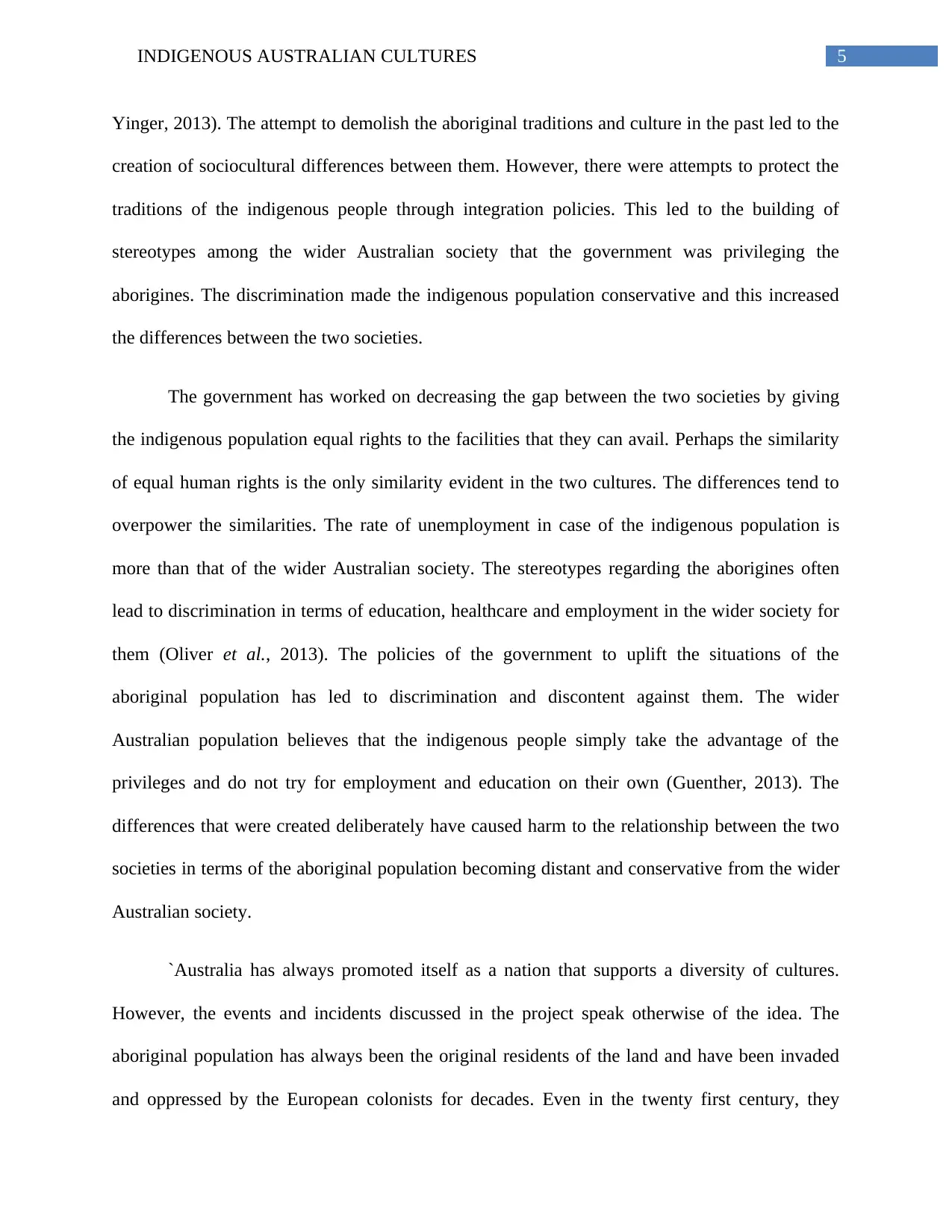
5INDIGENOUS AUSTRALIAN CULTURES
Yinger, 2013). The attempt to demolish the aboriginal traditions and culture in the past led to the
creation of sociocultural differences between them. However, there were attempts to protect the
traditions of the indigenous people through integration policies. This led to the building of
stereotypes among the wider Australian society that the government was privileging the
aborigines. The discrimination made the indigenous population conservative and this increased
the differences between the two societies.
The government has worked on decreasing the gap between the two societies by giving
the indigenous population equal rights to the facilities that they can avail. Perhaps the similarity
of equal human rights is the only similarity evident in the two cultures. The differences tend to
overpower the similarities. The rate of unemployment in case of the indigenous population is
more than that of the wider Australian society. The stereotypes regarding the aborigines often
lead to discrimination in terms of education, healthcare and employment in the wider society for
them (Oliver et al., 2013). The policies of the government to uplift the situations of the
aboriginal population has led to discrimination and discontent against them. The wider
Australian population believes that the indigenous people simply take the advantage of the
privileges and do not try for employment and education on their own (Guenther, 2013). The
differences that were created deliberately have caused harm to the relationship between the two
societies in terms of the aboriginal population becoming distant and conservative from the wider
Australian society.
`Australia has always promoted itself as a nation that supports a diversity of cultures.
However, the events and incidents discussed in the project speak otherwise of the idea. The
aboriginal population has always been the original residents of the land and have been invaded
and oppressed by the European colonists for decades. Even in the twenty first century, they
Yinger, 2013). The attempt to demolish the aboriginal traditions and culture in the past led to the
creation of sociocultural differences between them. However, there were attempts to protect the
traditions of the indigenous people through integration policies. This led to the building of
stereotypes among the wider Australian society that the government was privileging the
aborigines. The discrimination made the indigenous population conservative and this increased
the differences between the two societies.
The government has worked on decreasing the gap between the two societies by giving
the indigenous population equal rights to the facilities that they can avail. Perhaps the similarity
of equal human rights is the only similarity evident in the two cultures. The differences tend to
overpower the similarities. The rate of unemployment in case of the indigenous population is
more than that of the wider Australian society. The stereotypes regarding the aborigines often
lead to discrimination in terms of education, healthcare and employment in the wider society for
them (Oliver et al., 2013). The policies of the government to uplift the situations of the
aboriginal population has led to discrimination and discontent against them. The wider
Australian population believes that the indigenous people simply take the advantage of the
privileges and do not try for employment and education on their own (Guenther, 2013). The
differences that were created deliberately have caused harm to the relationship between the two
societies in terms of the aboriginal population becoming distant and conservative from the wider
Australian society.
`Australia has always promoted itself as a nation that supports a diversity of cultures.
However, the events and incidents discussed in the project speak otherwise of the idea. The
aboriginal population has always been the original residents of the land and have been invaded
and oppressed by the European colonists for decades. Even in the twenty first century, they
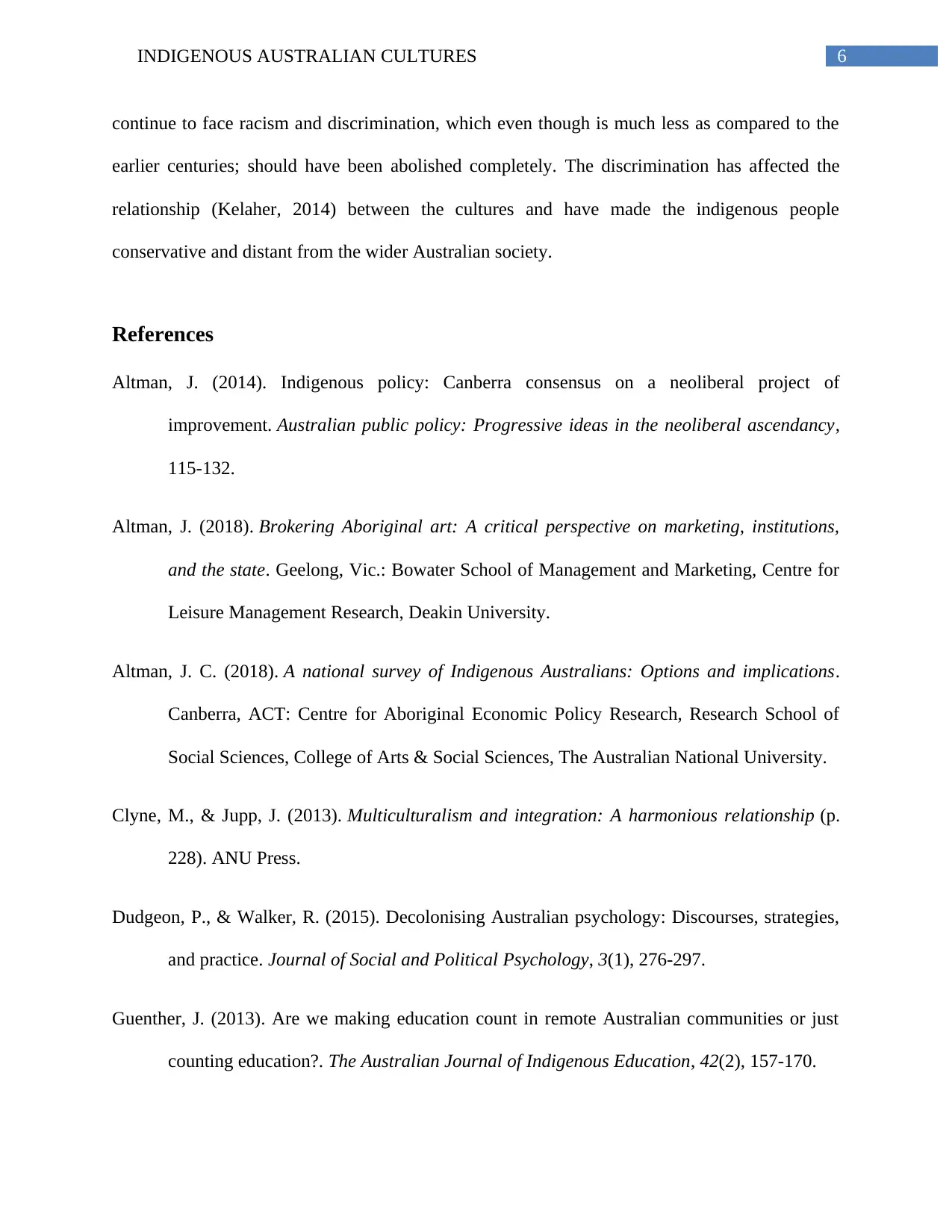
6INDIGENOUS AUSTRALIAN CULTURES
continue to face racism and discrimination, which even though is much less as compared to the
earlier centuries; should have been abolished completely. The discrimination has affected the
relationship (Kelaher, 2014) between the cultures and have made the indigenous people
conservative and distant from the wider Australian society.
References
Altman, J. (2014). Indigenous policy: Canberra consensus on a neoliberal project of
improvement. Australian public policy: Progressive ideas in the neoliberal ascendancy,
115-132.
Altman, J. (2018). Brokering Aboriginal art: A critical perspective on marketing, institutions,
and the state. Geelong, Vic.: Bowater School of Management and Marketing, Centre for
Leisure Management Research, Deakin University.
Altman, J. C. (2018). A national survey of Indigenous Australians: Options and implications.
Canberra, ACT: Centre for Aboriginal Economic Policy Research, Research School of
Social Sciences, College of Arts & Social Sciences, The Australian National University.
Clyne, M., & Jupp, J. (2013). Multiculturalism and integration: A harmonious relationship (p.
228). ANU Press.
Dudgeon, P., & Walker, R. (2015). Decolonising Australian psychology: Discourses, strategies,
and practice. Journal of Social and Political Psychology, 3(1), 276-297.
Guenther, J. (2013). Are we making education count in remote Australian communities or just
counting education?. The Australian Journal of Indigenous Education, 42(2), 157-170.
continue to face racism and discrimination, which even though is much less as compared to the
earlier centuries; should have been abolished completely. The discrimination has affected the
relationship (Kelaher, 2014) between the cultures and have made the indigenous people
conservative and distant from the wider Australian society.
References
Altman, J. (2014). Indigenous policy: Canberra consensus on a neoliberal project of
improvement. Australian public policy: Progressive ideas in the neoliberal ascendancy,
115-132.
Altman, J. (2018). Brokering Aboriginal art: A critical perspective on marketing, institutions,
and the state. Geelong, Vic.: Bowater School of Management and Marketing, Centre for
Leisure Management Research, Deakin University.
Altman, J. C. (2018). A national survey of Indigenous Australians: Options and implications.
Canberra, ACT: Centre for Aboriginal Economic Policy Research, Research School of
Social Sciences, College of Arts & Social Sciences, The Australian National University.
Clyne, M., & Jupp, J. (2013). Multiculturalism and integration: A harmonious relationship (p.
228). ANU Press.
Dudgeon, P., & Walker, R. (2015). Decolonising Australian psychology: Discourses, strategies,
and practice. Journal of Social and Political Psychology, 3(1), 276-297.
Guenther, J. (2013). Are we making education count in remote Australian communities or just
counting education?. The Australian Journal of Indigenous Education, 42(2), 157-170.
Paraphrase This Document
Need a fresh take? Get an instant paraphrase of this document with our AI Paraphraser
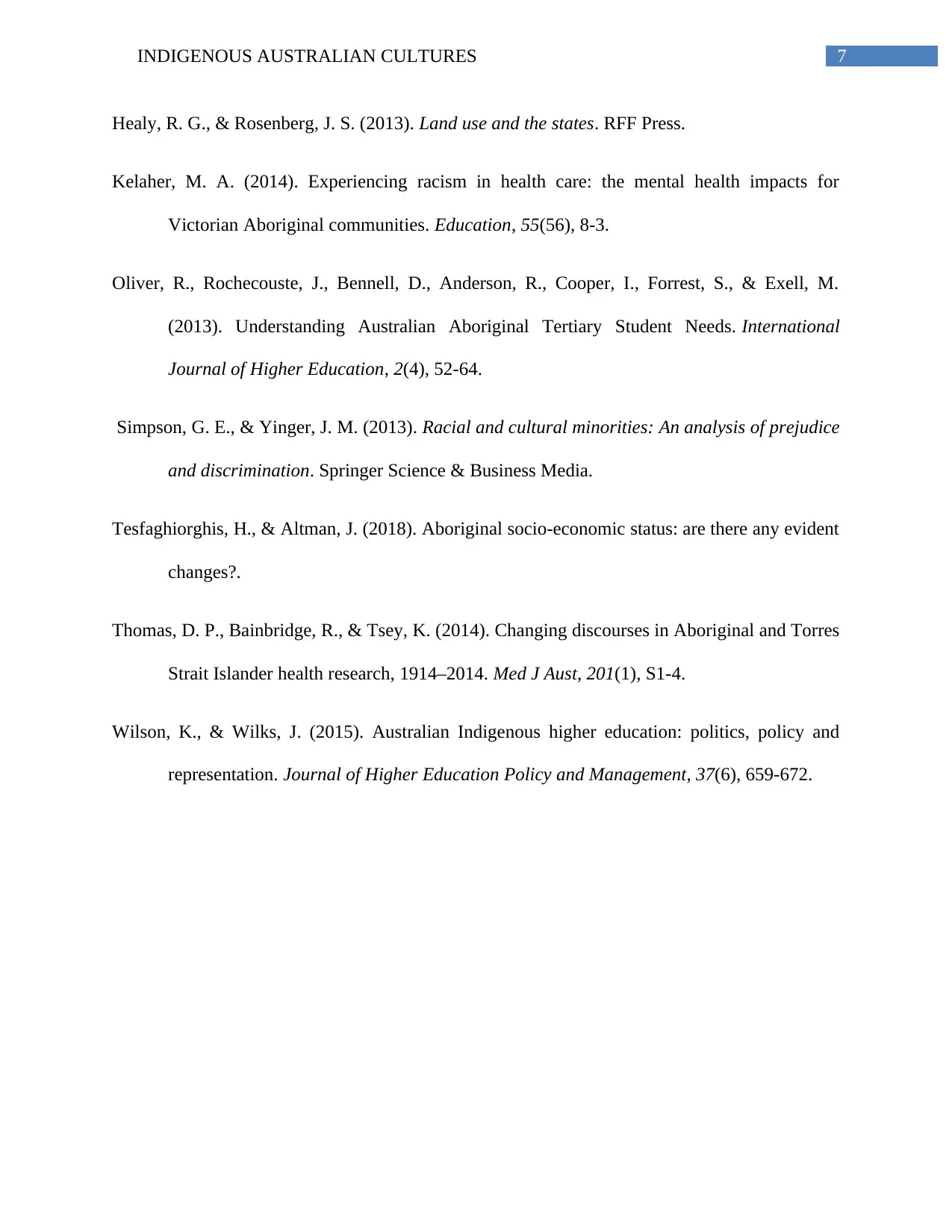
7INDIGENOUS AUSTRALIAN CULTURES
Healy, R. G., & Rosenberg, J. S. (2013). Land use and the states. RFF Press.
Kelaher, M. A. (2014). Experiencing racism in health care: the mental health impacts for
Victorian Aboriginal communities. Education, 55(56), 8-3.
Oliver, R., Rochecouste, J., Bennell, D., Anderson, R., Cooper, I., Forrest, S., & Exell, M.
(2013). Understanding Australian Aboriginal Tertiary Student Needs. International
Journal of Higher Education, 2(4), 52-64.
Simpson, G. E., & Yinger, J. M. (2013). Racial and cultural minorities: An analysis of prejudice
and discrimination. Springer Science & Business Media.
Tesfaghiorghis, H., & Altman, J. (2018). Aboriginal socio-economic status: are there any evident
changes?.
Thomas, D. P., Bainbridge, R., & Tsey, K. (2014). Changing discourses in Aboriginal and Torres
Strait Islander health research, 1914–2014. Med J Aust, 201(1), S1-4.
Wilson, K., & Wilks, J. (2015). Australian Indigenous higher education: politics, policy and
representation. Journal of Higher Education Policy and Management, 37(6), 659-672.
Healy, R. G., & Rosenberg, J. S. (2013). Land use and the states. RFF Press.
Kelaher, M. A. (2014). Experiencing racism in health care: the mental health impacts for
Victorian Aboriginal communities. Education, 55(56), 8-3.
Oliver, R., Rochecouste, J., Bennell, D., Anderson, R., Cooper, I., Forrest, S., & Exell, M.
(2013). Understanding Australian Aboriginal Tertiary Student Needs. International
Journal of Higher Education, 2(4), 52-64.
Simpson, G. E., & Yinger, J. M. (2013). Racial and cultural minorities: An analysis of prejudice
and discrimination. Springer Science & Business Media.
Tesfaghiorghis, H., & Altman, J. (2018). Aboriginal socio-economic status: are there any evident
changes?.
Thomas, D. P., Bainbridge, R., & Tsey, K. (2014). Changing discourses in Aboriginal and Torres
Strait Islander health research, 1914–2014. Med J Aust, 201(1), S1-4.
Wilson, K., & Wilks, J. (2015). Australian Indigenous higher education: politics, policy and
representation. Journal of Higher Education Policy and Management, 37(6), 659-672.
1 out of 8
Related Documents
Your All-in-One AI-Powered Toolkit for Academic Success.
+13062052269
info@desklib.com
Available 24*7 on WhatsApp / Email
![[object Object]](/_next/static/media/star-bottom.7253800d.svg)
Unlock your academic potential
© 2024 | Zucol Services PVT LTD | All rights reserved.





